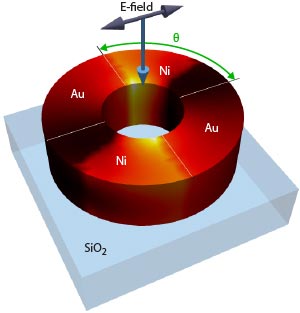Doubling up improves nanoring design

When a light pulse (black arrow indicates its electric field and blue arrow shows propagation direction) is irradiated on a nanoring made of nickel and gold on silica substrate (blue), the nanoring generates a magnetic pulse via the thermoelectric effect. Adapted from Ref. 1 and licensed under CC-BY-3.0 © 2015 G. Vienne et al.
A bimetallic nanoring that generates a short magnetic pulse when irradiated by a laser pulse has been theoretically studied by researchers at Singapore's Agency for Science, Technology and Research (A*STAR). It shows exciting potential for investigating magnetic switching and realizing rapid data storage [1].
Unlike their electrical and optical equivalents, ultrashort magnetic pulses have proved very difficult to generate. These pulses are needed to explore magnetic switching in materials — a process that underpins virtually all of today’s data storage technology. However, most methods for generating magnetic pulses use large-scale particle accelerators or are limited to specific materials and do not produce tightly confined magnetic fields.
Now, Guillaume Vienne and colleagues at the A*STAR Data Storage Institute have theoretically proposed a nanoring that consists of four alternating gold and nickel sectors (see image). Their calculations predict that this nanoring will generate magnetic pulses shorter than a trillionth of a second when irradiated by an ultrashort laser pulse.
The ring is essentially a nanoscale version of the setup used by physicist Thomas Seebeck in 1821 when he discovered that a temperature difference produces an electric voltage in certain materials — now known as the thermoelectric effect. The nanoring operates in a similar way to Seebeck’s setup in that heating it produces an uneven temperature distribution, which results in current flow and generates a magnetic field.
The nanoring is heated by irradiation with a laser pulse. Its small size gives rise to resonant collective oscillations of conduction electrons, known as plasmon resonance. This results in efficient and uneven heating, producing hot and cool spots in the ring between which currents flow as a result of the thermoelectric effect. Finally, these currents generate a magnetic pulse.
Vienne sees the nanoring as being unique. “There simply isn’t any source that produces a magnetic field that is so localized in both time and space. So it’s a kind of a new object,” he enthuses.
The four-sector nanoring has two significant advantages over a previous design that had only two sectors. It generates a higher current and hence a higher magnetic field. In addition, the four-sector nanoring has a lower maximum temperature, which is fortunate since the ring will melt if its maximum temperature exceeds its melting point.
The A*STAR team is currently collaborating with scientists at Southampton University in the United Kingdom to fabricate and characterize such a nanoring.
The researchers are enthusiastic about its potential. “There is much debate about how fast magnetization can be switched,” says Vienne. “Our nanoring should advance that debate.”
The A*STAR-affiliated researchers contributing to this research are from the Data Storage Institute. For more information about the team’s research, please visit the Advanced Concepts and Nanotechnology webpage.
Reference
[1] Vienne, G., Chen, X., Teh, Y. S., Ng, Y. J., Chia, N. O. & Ooi, C. P. Novel layout of a bi-metallic nanoring for magnetic field pulse generation from light. New Journal of Physics 17, 013409 (2015).
Associated links
Original article from A*STAR Research
Media Contact
More Information:
http://www.researchsea.comAll latest news from the category: Materials Sciences
Materials management deals with the research, development, manufacturing and processing of raw and industrial materials. Key aspects here are biological and medical issues, which play an increasingly important role in this field.
innovations-report offers in-depth articles related to the development and application of materials and the structure and properties of new materials.
Newest articles

A universal framework for spatial biology
SpatialData is a freely accessible tool to unify and integrate data from different omics technologies accounting for spatial information, which can provide holistic insights into health and disease. Biological processes…

How complex biological processes arise
A $20 million grant from the U.S. National Science Foundation (NSF) will support the establishment and operation of the National Synthesis Center for Emergence in the Molecular and Cellular Sciences (NCEMS) at…

Airborne single-photon lidar system achieves high-resolution 3D imaging
Compact, low-power system opens doors for photon-efficient drone and satellite-based environmental monitoring and mapping. Researchers have developed a compact and lightweight single-photon airborne lidar system that can acquire high-resolution 3D…





















